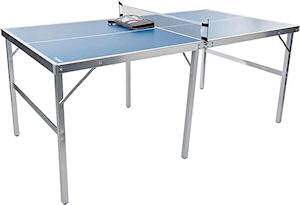
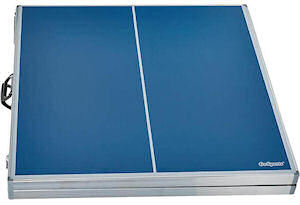
What do the hand signals used by umpires mean and when are they used?
Find out here.
By Martin Hughes
Owner and Editor
GREAT GIFTS
Portable Table Tennis Table.


Table Tennis Net, Rackets, Ball and Case.

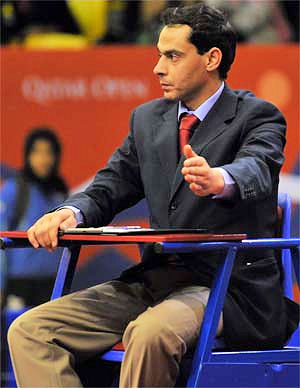
by courtesy of the ITTF
In 1981 the International Table Tennis Federation (ITTF) introduced hand signals for use by international umpires.
So, in addition to controlling the match with verbal communication, umpires can also use approved hand signals to indicate certain decisions.
This is especially useful where the noise level makes it difficult for the umpire to be heard.
Umpires are instructed that these hand signals should be clear and positive but not unnecessarily flamboyant or aggressive.
Umpires must also ensure that hand signals are clearly separated. For example, they should not indicate a point scored with one arm and simultaneously indicate the next server with the other arm.
However, we need to be aware that the use of hand signals is included in the Regulations for International Competitions rather than the Laws (rules) of table tennis.

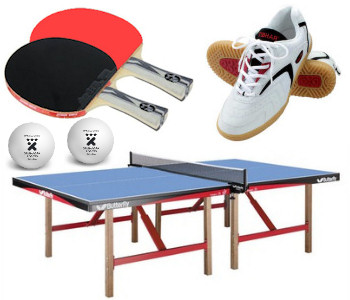
Before we go any further, it's worth noting the difference between the Laws (commonly referred to as the rules) of the game and the Regulations.
The Laws are the "basic" rules of the game and are mandatory for all sanctioned table tennis events, whereas the Regulations are supplementary to the Laws and are only mandatory for ITTF (International) events.
However, the Regulations may also be used for non ITTF events and it is for the event organiser to decide whether they will use any or all of the Regulations.
So the Regulations may or may not always apply. As a general rule, the higher the level of competition, the more likely it is that some or all of the Regulations will be used in addition to the basic Laws.


So let's take a look at the three most common hand signals.
Umpires hand signal for next server
At the start of a match or game the umpire should.
The score 0 may be expressed as either "zero" or "love".
In a team match the name of the Association may be used instead of, or as well as, the player's name - for example "Smith of England to serve" or "England to serve".
This hand signal is also used when a change of server is due. The umpire should point to the next server with an open hand.
This may be followed by the name of the next server, but this should be decided before the event starts so that all umpires at an event act consistently.
Need your questions about the Rules and Regulations answered SIMPLY and CLEARLY?
Take a look at this fully up-to-date downloadable book. You'll find everything you need.
Get all the details here.
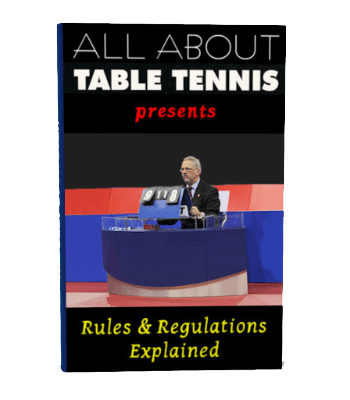
This new book explains SIMPLY and CLEARLY everything you need to know about the rules and regulations of table tennis.

Let's now look at the hand signal for a.
Umpires hand signal for a let
When the umpire declares a let, he or she should raise one hand above their head.
If there is an assistant umpire, he or she should also use the same hand signal to attract the umpire's attention when making a decision within his or her jurisdiction.
The umpire should then repeat the score to show that no point has been scored.
The same hand signal is also used when the umpire wishes to.
But the hand signal used most often is.
Umpires hand signal for a point
When a point has been won, the umpire should raise their arm on the side nearest to the player or pair who won it, so that their upper arm is horizontal and their forearm is vertical, with the closed hand upward.
The umpire should then call first the number of points scored by the player or pair due to serve next, then the number of points scored by the opposing player or pair.
The umpire should normally call the score as soon as the rally has been decided and not wait until he or she judges that the players are ready to resume play.
However, if there is loud applause or a player is retrieving the ball from the back of the playing area, the umpire may prefer to delay his or her call slightly until satisfied that the players will be able to hear it.
Need your questions about the Rules and Regulations answered SIMPLY and CLEARLY?
Take a look at this fully up-to-date downloadable book. You'll find everything you need.
Get all the details here.

This new book explains SIMPLY and CLEARLY everything you need to know about the rules and regulations of table tennis.

Let's now take a look at.
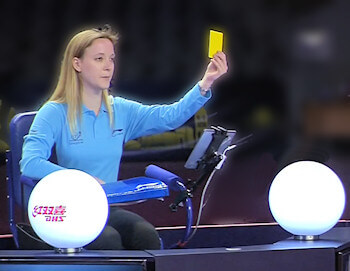
In 1991 the ITTF introduced yellow and red cards for misbehaviour and/or when the rules are broken.
When issuing a yellow or red card, the umpire should raise their arm above head height and hold up a yellow or red card towards the offender, without leaving their chair.
And in 1999 the ITTF introduced time-outs/white cards.
The umpire should use the same hand signal, i.e. raising their arm above head height - but with a white card.
And finally, let's take a look at.
In 2014 the ITTF proposed several new hand signals and a consultation process began.
These were all designed to indicate the umpire's decision in respect of illegal services.
Unfortunately it was impossible to have a single hand signal for all the different kinds of illegal service actions, so it was necessary to develop several hand signals.
Here are the various hand signals used to indicate which part of the service rule has been breached.
If the player requires further explanation, the umpire may also use the words shown.
These new hand signals for illegal services were implemented from Friday 1st July 2016.
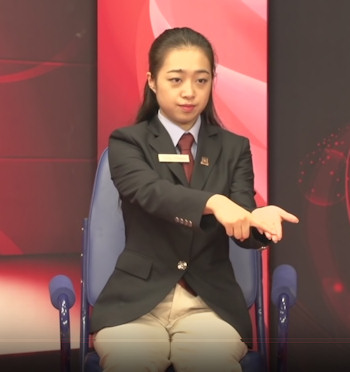
Ball not resting on palm.
In addition to this hand signal, the umpire can say . "ball resting on the fingers"
Contravenes Law (Rule) 2.06.01
Need your questions about the Rules and Regulations answered SIMPLY and CLEARLY?
Take a look at this fully up-to-date downloadable book. You'll find everything you need.
Get all the details here.

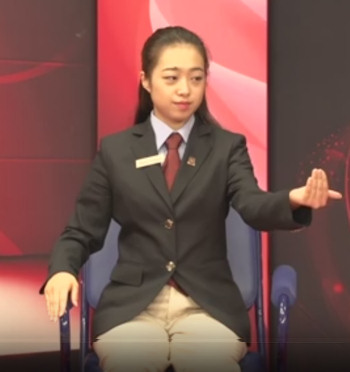
Palm not open and flat.
In addition to this hand signal, the umpire can say . "palm not opened"
Contravenes Law (Rule) 2.06.01
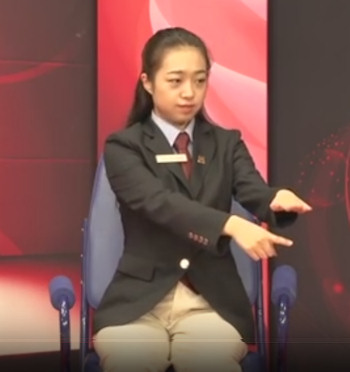
Ball not above the level of the playing surface.
In addition to this hand signal, the umpire can say . "below the playing surface"
Contravenes Law (Rule) 2.06.04
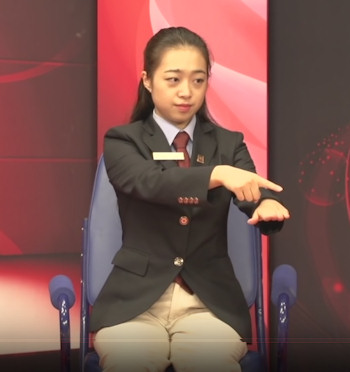
Ball not behind the server's end line.
In addition to this hand signal, the umpire can say . "inside the end line"
Contravenes Law (Rule) 2.06.04
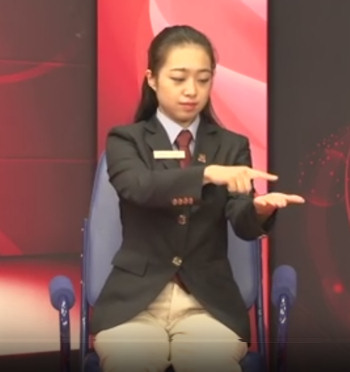
Ball not thrown up at least 16cm (approx 6 inches).
In addition to this hand signal, the umpire can say . "not high enough"
Contravenes Law (Rule) 2.06.02
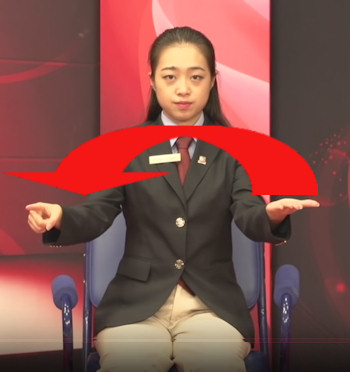
Ball not projected near vertically upwards.
The finger will indicate an arc shape.
In addition to this hand signal, the umpire can say . "not vertically"
Contravenes Law (Rule) 2.06.02
Need your questions about the Rules and Regulations answered SIMPLY and CLEARLY?
Take a look at this fully up-to-date downloadable book. You'll find everything you need.
Get all the details here.

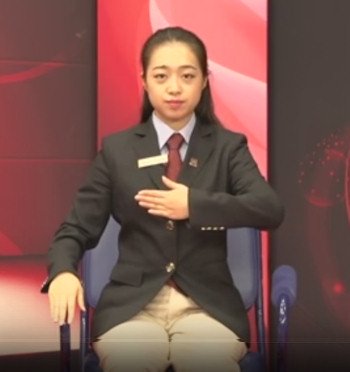
Ball hidden from the receiver.
In addition to this hand signal, the umpire can say . "hidden by (elbow / shoulder / head / partner)"
Contravenes Law (Rule) 2.06.04
Source: ITTF Handbook for Match Officials
Details about who are the table tennis officials can be found here.
2024 Olympic Games - Paris, France
2020 Olympic Games - Tokyo, Japan
2016 Olympic Games - Rio de Janeiro, Brazil
2012 Olympic Games - London, England
2008 Olympic Games - Beijing, China
2004 Olympic Games - Athens, Greece
2024 World Team Championships - Busan, South Korea
2023 World Championships - Durban, South Africa
2022 World Team Championships - Chengdu, China
2021 World Championships - Houston, USA
2020 World Team Championships - Busan, South Korea
2019 World Championships - Budapest, Hungary
2018 World Team Championships - Halmstad, Sweden
2017 World Championships - Dusseldorf, Germany
2016 World Team Championships - Kuala Lumpur, Malaysia
2015 World Championships - Suzhou, China
2014 World Team Championships - Tokyo, Japan
2013 World Championships - Paris, France
2012 World Team Championships - Dortmund, Germany
2011 World Championships - Rotterdam, Netherlands
2010 World Team Championships - Moscow, Russia
2009 World Championships - Yokohama, Japan
ITTF Pro Tour (1996-2011)
ITTF World Tour (2012-2016)
ITTF World Tour (2017-2020)
Men's World Cup
2022 European Championships - Munich, Germany
2020/21 European Championships - Warsaw, Poland
2019 European Championships - Nantes, France
2018 European Championships - Alicante, Spain
2017 European Championships - Luxembourg, Luxembourg
2016 European Championships - Budapest, Hungary
2015 European Championships - Russia, Ekaterinburg
2014 European Championships - Lisbon, Portugal
2013 European Championships - Schwechat, Austria
2012 European Championships - Herning, Denmark
2011 European Championships - Gdansk/Sopot, Poland
2010 European Championships - Ostrava, Czech Republic
2009 European Championships - Stuttgart, Germany
2008 European Championships - St Petersburg, Russia
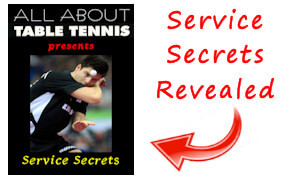

This site is built using Solo Build It!
AllAboutTableTennis.com (AATT) is completely free to use.
However, it's run by one person only (Martin Hughes) and has high running costs that need to be paid for.
This web site receives thousands of visitors every day and therefore, to keep it completely free to use, advertising and affiliate links appear on this web site.
However, these adverts and affiliate links do not influence the advice and recommendations given on this web site.
My intention has always been to give you the best possible information, advice and recommendations, based on my 50+ years involvement in the sport.
Adverts appear automatically on my site, provided by third parties, and are not directly controlled by me.
When you click on an advert, it's tracked to AATT and will generate a small payment to me.
Affiliate links are links to other web sites who sell related table tennis products.
These work in the same way as normal links, but when you click on it, the link is tracked to AATT and, if you make a purchase, may generate a small payment to me.
They do not cost you anything to use, and any products you choose to buy will not cost you any more than if you went directly to that web site.
These are principally links to Megaspin, Amazon and Bribar, but may include others from time to time.
These links are identified by having an asterisk (*) by its side.
AATT cannot identify any user who clicks on an advert or affiliate link.